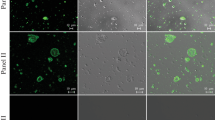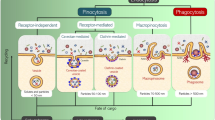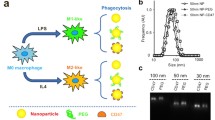Abstract
Purpose. We compared cationic, polyamine-coated microparticles (MPs) and anionic, protein-coated MPs with respect to their phagocytosis and phagosomal fate in dendritic cells (DCs) and macrophages (MΦ).
Methods. Polystyrene MPs were surface modified by covalent coupling with fluorescein isothiocyanate-labeled polyamines or proteins. Phagocytosis of MP and the pH of their intracellular microenvironment was assessed in human-derived DCs and MΦ in a fluorescence plate reader. Visualization of MP phagocytosis in DCs was performed by transmission electron microscopy.
Results. Phagocytosis of bovine serum albumin-coated MPs was low with significant differences between DC and MΦ, whereas phagocytosis of IgG-coated MPs was significantly enhanced in both cell types. Phagocytosis of both particle types resulted in an acidified phagosomal microenvironment (pH 4.6-5.1). In contrast, cationic, polyamine-coated MPs were equally phagocytosed by DCs and MΦ to a high extent and showed lower degrees of acidification (pH 6.0-6.8) in the phagosomal microenvironment. Transmission electron microscopy examination demonstrated all phagocytosed particles to be surrounded by a phagosomal membrane, which was more tightly apposed to the surface of cationic MPs and more loosely to bovine serum albumin-coated MPs.
Conclusion. Phagocytosis of cationic, polyamine-coated MPs is suggested to lead to diminished phagosomal acidification. Thus, cationic MP are potential carriers that may display beneficial features for the intracellular delivery of immunomodulating therapeutics and their protection against lysosomal degradation.
Similar content being viewed by others
REFERENCES
S. Raychaudhuri and K. L. Rock. Fully mobilizing host defense: building better vaccines. Nat. Biotech. 16:1025-1031 (1998).
E. Walter, D. Dreher, M. Kok, L. Thiele, S. G. Kiama, P. Gehr, and H. P. Merkle. Hydrophilic poly(DL-lactide-co-glycolide) microspheres for the delivery of DNA to human-derived macrophages and dendritic cells. J. Control. Release 76:149-168 (2001).
S. Prior, B. Gander, N. Blarer, H. P. Merkle, M. L. Subria, J. M. Irache, and C. Gamazo. In vitro phagocytosis and monocyte-macrophage activation with poly(lactide) and poly(lactide-co-glycolide) microspheres. Eur. J. Pharm. Sci. 15:197-207 (2002).
J. Banchereau, F. Briere, C. Caux, J. Davoust, S. Lebecque, Y. J. Liu, B. Pulendran, and K. Palucka. Immunobiology of dendritic cells. Annu. Rev. Immunol. 18:767-811 (2000).
A. Aderem and D. M. Underhill. Mechanisms of phagocytosis in macrophages. Annu. Rev. Immunol. 17:593-623 (1999).
J. Banchereau and R. M. Steinman. Dendritic cells and the control of immunity. Nature 392:245-252 (1998).
F. D. Finkelman, A. Lees, R. Birnbaum, W. C. Gause, and S. C. Morris. Dendritic cells can present antigens in vivo in a tolerogenic or immunogenic fashion. J. Immunol. 157:1406-1414 (1996).
Y. Men, H. Tamber, R. Audran, B. Gander, and G. Corradin. Induction of a cytotoxic T lymphocyte response by immunization with a malaria specific CTL peptide entrapped in biodegradable polymer microspheres. Vaccine 15:1405-1412 (1997).
K. Peter, Y. Men, G. Pantaleo, B. Gander, and G. Corradin. Induction of a cytotoxic T-cell response to HIV-1 proteins with short synthetic peptides and human compatible adjuvants. Vaccine 19:4121-4129 (2001).
Z. Shen, G. Reznikoff, G. Dranoff, and K. L. Rock. Cloned dendritic cells can present exogenous antigens on both MHC class I and class II molecules. J. Immunol. 158:2723-2730 (1997).
M. Svensson, B. Stockinger, and M. J. Wick. Bone marrow-derived dendritic cells can process bacteria for MHC-I and MHC-II presentation to T cells. J. Immunol. 158:4229-4236 (1997).
C. Scheicher, M. Mehlig, H. P. Dienes, and K. Reske. Uptake of microparticle-adsorbed protein antigen by bone marrow-derived dendritic cells results in up-regulation of interleukin-1 alpha and interleukin-12 p40/p35 and triggers prolonged, efficient antigen presentation. Eur. J. Immunol. 25:1566-1572 (1995).
M. Kovacsovics-Bankowski and K. L. Rock. A phagosome-to-cytosol pathway for exogenous antigens presented on MHC class I molecules. Science 267:243-246 (1995).
L. Thiele, B. Rothen-Rutishauser, S. Jilek, H. Wunderli-Allenspach, H. P. Merkle, and E. Walter. Evaluation of particle uptake in human blood monocyte-derived cells in vitro. Does phagocytosis activity of dendritic cells measure up with macrophages? J. Control. Release 76:59-71 (2001).
Y. Tabata and Y. Ikada. Phagocytosis of polymer microspheres by macrophages. Adv. Polymer Sci. 94:107-141 (1990).
H. Ayhan, A. Tuncel, N. Bor, and E. Piskin. Phagocytosis of monosize polystyrene-based microspheres having different size and surface properties. J. Biomat. Sci. 7:329-342 (1995).
M. Singh, M. Briones, G. Ott, and D. O'Hagan. Cationic microparticles: a potent delivery system for DNA vaccines. Proc. Natl. Acad. Sci. USA 97:811-816 (2000).
S. G. Kiama, L. Cochand, L. Karlsson, L. P. Nicod, and P. Gehr. Evaluation of phagocytic activity in human monocyte-derived dendritic cells. J. Aerosol Med. 14:289-299 (2001).
C. R. Sousa and J. M. Austyn. Phagocytosis of antigens by Langerhans cells. Adv. Exp. Med. Biol. 329:199-204 (1993).
J. A. Swanson and S. C. Baer. Phagocytosis by zippers and triggers. Trends Cell Biol. 5:89-93 (1995).
C. De Chastellier and L. Thilo. Phagosome maturation and fusion with lysosomes in relation to surface property and size of the phagocytic particle. Eur. J. Cell Biol. 74:49-62 (1997).
J. A. Swanson and C. Watts. Macropinocytosis. Trends Cell Biol. 5:424-428 (1995).
E. Walter and H. P. Merkle. Microparticle-mediated transfection of non-phagocytic cells in vitro. J. Drug Target. 10:11-21 (2002).
K. S. Denis-Mize, M. Dupuis, M. L. MacKichan, M. Singh, B. Doe, D. O'Hagan, J. B. Ulmer, J. J. Donnelly, D. M. McDonald, and G. Ott. Plasmid DNA adsorbed onto cationic microparticles mediates target gene expression and antigen presentation by dendritic cells. Gene Ther. 7:2105-2112 (2000).
M. J. Mahoney and W. M. Saltzman. Transplantation of brain cells assembled around a programmable synthetic microenvironment. Nat. Biotech. 19:934-939 (2001).
J. P. Behr. Gene transfer with amino lipids and amino polymers. Compt. Rend. Seanc. Soc. Biol. 190:33-38 (1996).
A. Lorenzen and S. W. Kennedy. A fluorescence-based protein assay for use with a microplate reader. Anal. Biochem. 214:346-348 (1993).
T. Arvinte, A. Cudd, and A. F. Drake. The structure and mechanism of formation of human calcitonin fibrils. J. Biol. Chem. 268:6415-6422 (1993).
R. H. Müller, S. S. Davis, L. Illum, and E. Mak. Particle Charge and Surface Hydrophobicity of Colloidal Carriers. In G. Gregoriedes, J. Senior, and G. Poste (eds.), Targeting of drugs with synthetic system, Plenum, New York 1986, pp. 239-263.
F. Sallusto, M. Cella, C. Danieli, and A. Lanzavecchia. Dendritic cells use macropinocytosis and the mannose receptor to concentrate macromolecules in the major histocompatibility complex class II compartment: downregulation by cytokines and bacterial products. J. Exp. Med. 182:389-400 (1995).
F. Gantner, R. Kupferschmidt, C. Schudt, A. Wendel, and A. Hatzelmann. In vitro differentiation of human monocytes to macrophages: change of PDE profile and its relationship to suppression of tumour necrosis factor-alpha release by PDE inhibitors. Br. J. Pharmacol. 121:221-231 (1997).
L. Cochand, P. Isler, F. Songeon, and L. P. Nicod. Human lung dendritic cells have an immature phenotype with efficient mannose receptors. Am. J. Respir. Cell Mol. Biol. 21:547-554 (1999).
J. M. Coco-Martin, J. W. Oberink, T. A. van der Velden-de Groot, and E. C. Beuvery. Viability measurements of hybridoma cells in suspension cultures. Cytotechnology 8:57-64 (1992).
M. J. Geisow. Fluorescein conjugates as indicators of subcellular pH. A critical evaluation. Exp. Cell Res. 150:29-35 (1984).
G. P. Downey, R. J. Botelho, J. R. Butler, Y. Moltyaner, P. Chien, A. D. Scheiber, and S. Grinstein. Phagosomal maturation, acidification, and inhibition of bacterial growth in nonphagocytic cells transfected with FcγRIIA receptors. J. Biol. Chem. 274:28436-28444 (1999).
R. H. Muller. Colloidal Carriers for Controlled Drug Delivery and Targeting. Wissenschaftliche Verlagsgesellschaft Stuttgart, 1990.
B. Poole and S. Ohkuma. Effect of weak bases on the intralysosomal pH in mouse peritoneal macrophages. J. Cell Biol. 90:665-669 (1981).
S. Ohkuma, J. Chudzik, and B. Poole. The effects of basic substances and acidic ionophores on the digestion of exogenous and endogenous proteins in mouse peritoneal macrophages. J. Cell Biol. 102:959-966 (1986).
P. Erbacher, J. S. Remy, and J. P. Behr. Gene transfer with synthetic virus-like particles via the integrin-mediated endocytosis pathway. Gene Ther. 6:138-145 (1999).
S. E. Fong, P. Smanik, M. C. Smith, and S. R. Jaskunas. Cationic liposome-mediated uptake of human immunodeficiency virus type 1 Tat protein into cells. J. Virol. Methods 66:149-157 (1997).
Y. Tabata and Y. Ikada. Effect of the size and surface charge of polymer microspheres on their phagocytosis by macrophage. Biomaterials 9:356-362 (1988).
F. M. Griffin, J. A. Griffin, J. E. Leider, and S. C. Silverstein. Studies on the mechanism of phagocytosis. I. Requirements for circumferential attachment of particle-bound ligands to specific receptors on the macrophage plasma membrane. J. Exp. Med. 142:1263-1282 (1975).
F. M. Griffin, J. A. Griffin, and S. C. Silverstein. Studies on the mechanism of phagocytosis. II. The interaction of macrophages with anti-immunoglobulin IgG-coated bone marrow-derived lymphocytes. J. Exp. Med. 144:788-809 (1976).
A. M. Torche, P. Le Corre, E. Albina, A. Jestin, and R. Le Verge. PLGA microspheres phagocytosis by pig alveolar macrophages: influence of poly(vinyl alcohol) concentration, nature of loaded-protein and copolymer nature. J. Drug Target. 7:343-354 (2000).
D. R. Absolom. Opsonins and dysopsonins: an overview. Methods Enzymol. 132:281-318 (1986).
K. Inaba, M. Inaba, M. Naito, and R. M. Steinman. Dendritic cell progenitors phagocytose particulates, including bacillus Calmette-Guerin organisms, and sensitize mice to mycobacterial antigens in vivo. J. Exp. Med. 178:479-488 (1993).
K. Matsuno, T. Ezaki, S. Kudo, and Y. Uehara. A life stage of particle-laden rat dendritic cells in vivo: their terminal division, active phagocytosis, and translocation from the liver to the draining lymph. J. Exp. Med. 183:1865-1878 (1996).
A. Regnault, D. Lankar, V. Lacabanne, A. Rodriguez, C. Thery, M. Rescigno, T. Saito, S. Verbeek, C. Bonnerot, P. Ricciardi-Castagnoli, and S. Amigorena. Fcg receptor-mediated induction of dendritic cell maturation and major histocompatibility complex class I-restricted antigen presentation after immune complex internalization. J. Exp. Med. 189:371-380 (1999).
D. Maurer, E. Fiebiger, B. Reininger, C. Ebner, P. Petzelbauer, G. P. Shi, H. A. Chapman, and G. Stingl. Fc epsilon receptor I on dendritic cells delivers IgE-bound multivalent antigens into a cathepsin S-dependent pathway of MHC class II presentation. J. Immunol. 161:2731-2739 (1998).
N. A. Fanger, D. Voigtlaender, C. Liu, S. Swink, K. Wardwell, J. Fisher, R. F. Graziano, L. C. Pfefferkorn, and P. M. Guyre. Characterization of expression, cytokine regulation, and effector function of the high affinity IgG receptor Fc gamma RI (CD64) expressed on human blood dendritic cells. J. Immunol. 158:3090-3098 (1997).
L. Josephson, C. H. Tung, A. Moore, and R. Weissleder. High-efficiency intracellular magnetic labeling with novel superparamagnetic-Tat peptide conjugates. Bioconjug. Chem. 10:186-191 (1999).
M. Desjardins. Biogenesis of phagolysosomes: the ‘kiss and run’ hypothesis. Trends Cell Biol. 5:183-187 (1995).
Author information
Authors and Affiliations
Corresponding author
Rights and permissions
About this article
Cite this article
Thiele, L., Merkle, H.P. & Walter, E. Phagocytosis and Phagosomal Fate of Surface-Modified Microparticles in Dendritic Cells and Macrophages. Pharm Res 20, 221–228 (2003). https://doi.org/10.1023/A:1022271020390
Issue Date:
DOI: https://doi.org/10.1023/A:1022271020390




